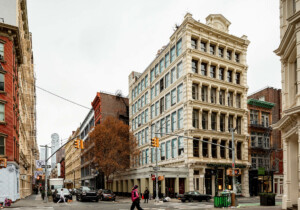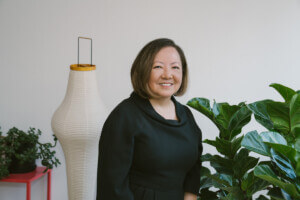Over the past several weeks, eight large-scale murals have been painted directly onto streets in all five boroughs of New York City, all of them borne from creative undertakings as disparate and complex as the communities where they’re found.
One, splayed in front of 725 Fifth Avenue in Manhattan in bright yellow road paint, was spearheaded—its location highly conspicuous and increasingly vandalism-prone—in part by the office of Mayor Bill de Blasio. Before that, on Fulton Street in Brooklyn’s historic Bedford-Stuyvesant neighborhood, came a community-led mural with a crucial assist from the Department of Transportation. On Adam Clayton Boulevard in Harlem, another mural came to fruition as an artist- and community-led effort, also with city support. Bronx, Queens, and Staten Island have them too, all organized and executed in different ways with different players.
“It’s really a mix,” Justin Garrett Moore, executive director of the city’s Public Design Commission, told AN with regard to how the eight murals came to be and who oversaw their creation. Yet despite their differences, all eight works of street art have the same, resounding three-word message spelled out in chunky, Paul Bunyan-sized lettering: Black Lives Matter.
However, one Black Lives Matter mural in New York City, at Foley Square in Lower Manhattan, is markedly different from the rest.
View this post on Instagram
The size of the Foley Square mural, which stretches across three blocks of Centre Street from the New York Supreme Court House to the Manhattan Municipal Building, is roughly comparable with the others, albeit perhaps a bit grander in scale at 600 feet long. It also eschews the straightforward, monochrome execution of some of, but not all of, the city’s Black Lives Matter murals in favor or 16 individual letters that are kaleidoscopic in nature. A veritable bonanza of colors, shapes, and designs, each letter can be viewed as a distinct, standalone work of art. In fact, three different artists—Tijay Mohammed (Black), Sophia Dawson (Lives), and Patrice Payne (Matter)—created each mammoth word.
Located in the civic heart of New York City adjacent to the historic site of the city’s African Burial Ground, the Black Lives Matter mural at Foley Square is the only one that’s creation was led by—and was largely funded in part by—architects, designers, and urban planners.
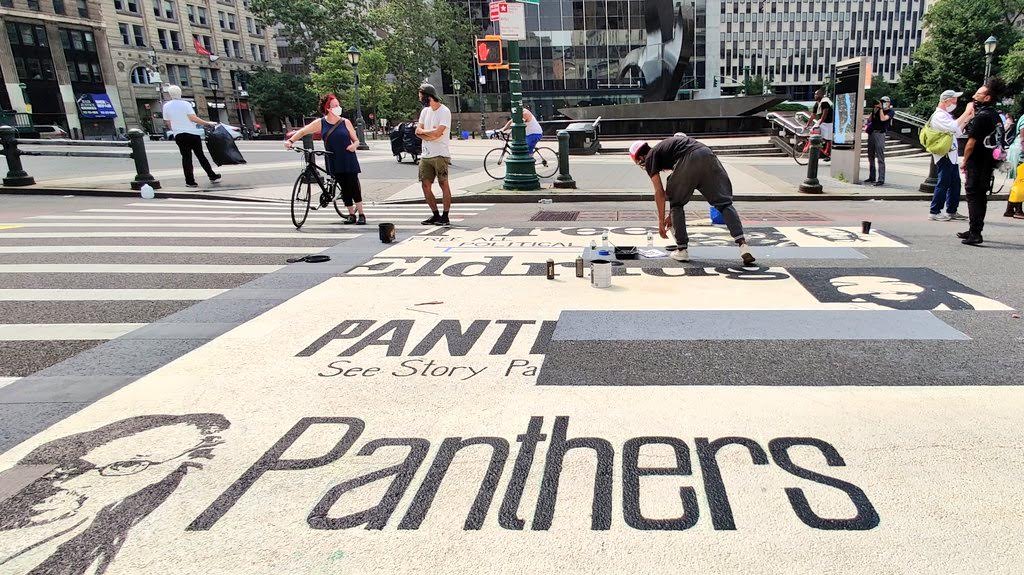
Public spaces are not neutral spaces
Like the other Black Lives Matter murals in New York, the mural at Foley Square follows in the oversized footsteps of the inaugural Black Lives Matter mural unveiled on June 5 just steps from the White House Lawn along 16th Street in Washington, D.C. The creation of that mural, led by D.C. Mayor Muriel Bowser, was spurred in the early days of the ongoing, Black Lives Matter-led movement—the largest and most enduring civil rights protest of its kind in decades—against social injustice, police brutality, and institutionalized racism. The movement was galvanized by the May 25 killing of George Floyd in Minneapolis along with the deaths of other Black Americans at the hands of law enforcement.
Similar to NYC’s other Black Lives Murals, the Foley Square mural involved the participation of city agencies and officials. A key player was Manhattan Borough President Gale Brewer, who, working in partnership with Black Lives Matter of Greater NY, was instrumental in selecting and securing the site. The 11-member Public Design Commission, which was involved more directly in the Foley Square mural than the others, is also a city agency and, as such, Moore served as a logistics-oriented choreographer of sorts, helping to coordinate between the impressive multitude of factions that contributed, artistically and financially to the mural. “Despite all the bad impressions people have about government, there were good people from multiple agencies working to make this happen,” he said. “There’s a lot of stuff that it takes to get stuff like this done.”
But as Moore clarified, the Foley Square mural was, in the end, “largely an independent effort, working between private and grassroots organizations.”
Moore went on to call the project “an unusual combination of people from the architecture, design, and built environment community that were motivated to really connect the mural idea to public space explicitly, and the idea to a civic center more explicitly.”
Working in concert with youth arts nonprofit Thrive Collective and technical artist support-providing TATS Cru, a Bronx-based collective of graffiti artists-turned muralists, on the planning/logistical front was WXY Architecture + Urban Design.
Amina Hassen, an associate and urban planner, and architect Jhordan Channer served as the firm’s project leads.
“For a long time, in both urban planning and in architecture, there has been a refusal to acknowledge how political our work really is,” said Hassen. “For me, personally, it feels very important at this point in time to acknowledge that as creators who are in positions to help shape the public realm that we come to it with our values and our political standings—because the places that we are involved in creating are not neutral spaces.”
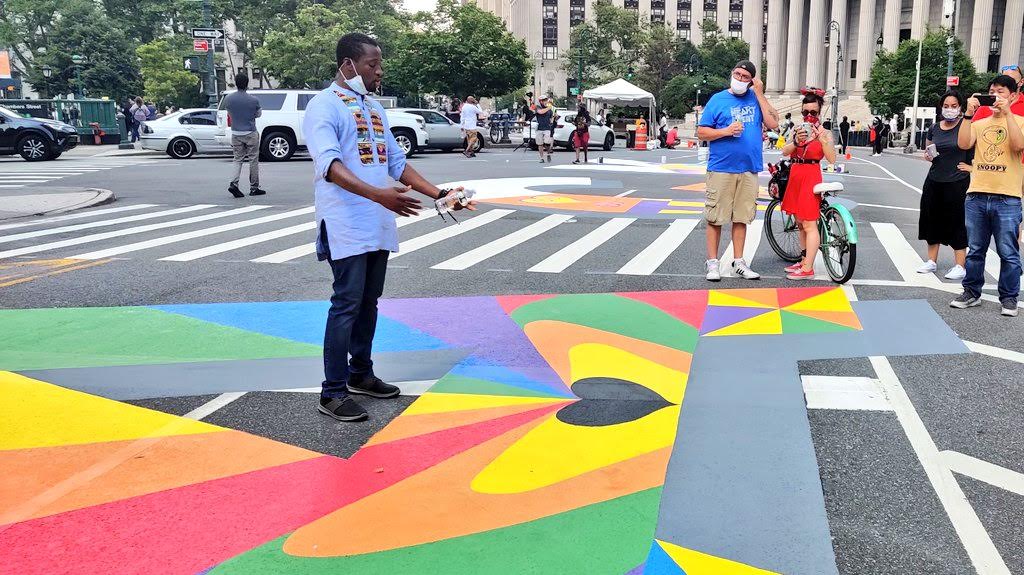
Referring to WXY as “true allies with the agency and resources and connections that absolutely helped make this happen,” Moore noted that the firm was also crucial in orchestrating a “peer network of design firms,” most of them based downtown, that leant financial support to the project. Firms that contributed were, among others, Snøhetta, COOKFOX, Rogers Partners, SCAPE, ODA, FXCollaborative, SHoP Architects, and Ken Smith Workshop. (A complete list can be found here.)
Janovic Paint & Decorating Center in SoHo and Benjamin Moore donated the 180 gallons of paint used to realize the mural, a work of public art that Channer referred to as “counter-narrative to the racist, colonial symbols in our public spaces.”
All good things take time
With so many players contributing artistically, technically, and fiscally, the mural at Foley Square took a bit longer to conceive and complete than its counterparts. (It was originally slated to be unveiled on Juneteenth but was completed July 3). This more deliberate pace, however, was largely by design as explained by Moore.
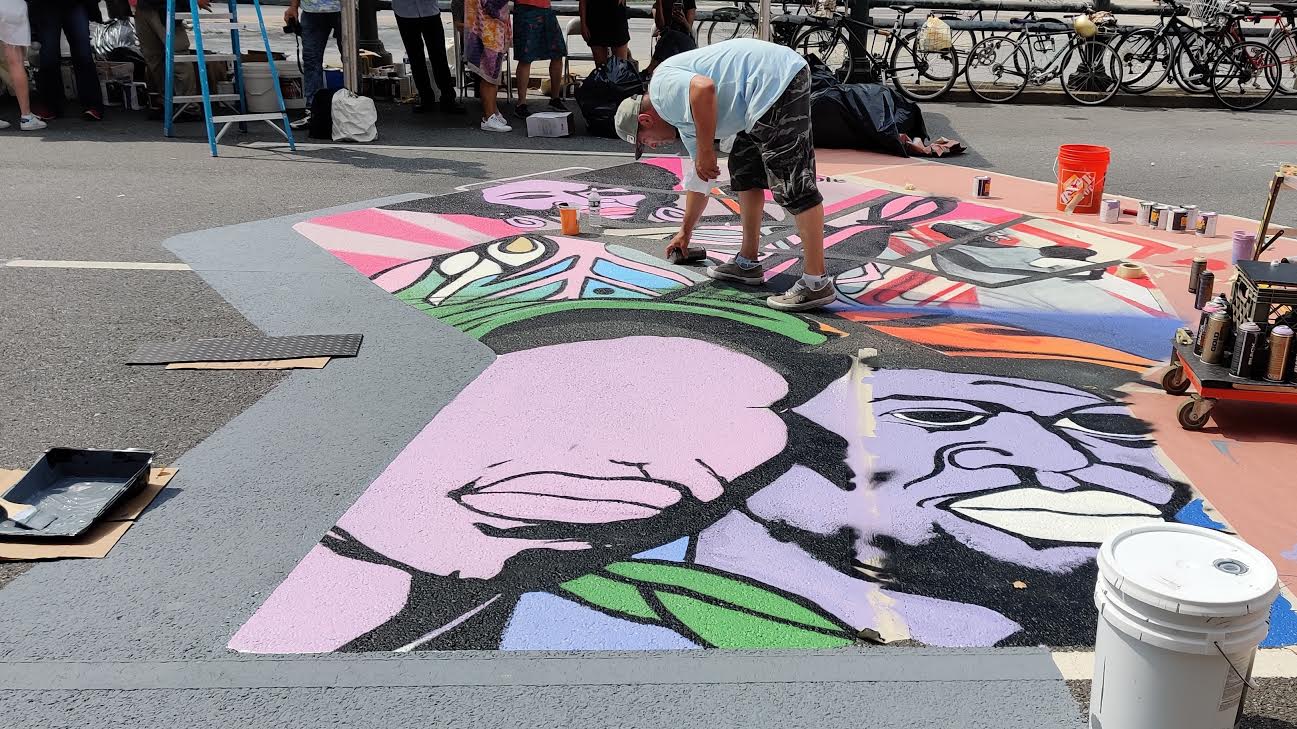
“It was really important that it was a broader effort; it took us more time to do it but it was important that how we did it really mattered,” he said. “The fact that we had so many participants and players was a part of that process.”
Moore also stressed the importance of a vetting process that was put in place to ensure that all donations and logistical support were “aligned with what Black Lives Matters is aligned with broadly. It took time to do that vetting and find the right partners to ensure that is was a coalition of people that were fully committed to the work,” he explained.
The involvement of Percent for Art, a program of the Department of Cultural Affairs, was also crucial in seeking out emerging artists in lieu of established ones with existing platforms and large followings. “It was a very intentional process,” said Moore. “People who aren’t normally given a platform and agency to do this kind of work were brought in.”
And as Moore added, the diversity of the statement—“Black Lives Matter”—is reflected in the artists themselves, who are of different religious backgrounds, genders, and sexual orientations. “Providing a platform for the artists to give this statement in their own voices was really important,” he said.
As for the Foley Square mural’s positioning amidst some of the city’s most powerful bureaucratic edifices, it was just as intentional as all other aspects of its creation.
Noting the proximity of the federal courthouse, New York City Police Department headquarters, and the African Burial Ground, Channer explained: “Conceptually, it’s an attempt to create a space on the street where people of color can exist […] it’s sort of labeled for them.”
Both Hassen and Channer were quick to emphasize the significance of their involvement in the mural as professional shapers of the built environment—an urban planner and an architect, respectively, both of color—who have direct hands in making public spaces more accessible and more equitable to all. “It was important that we became a part of this and really defined for ourselves what our streets look like and what those places we inhabit look like,” said Channer.
“Urbanists and architects have a lot of work to do to make Black Lives Matter in how we create and improve our public realm,” Hassen added. “By participating in this mural, it’s really just a statement of a start to rethinking our ways of working.”








